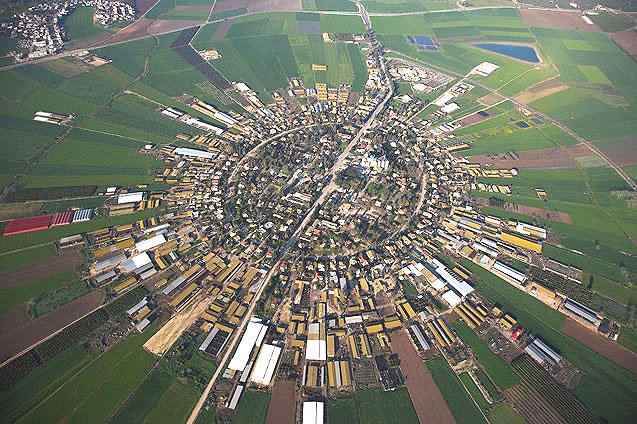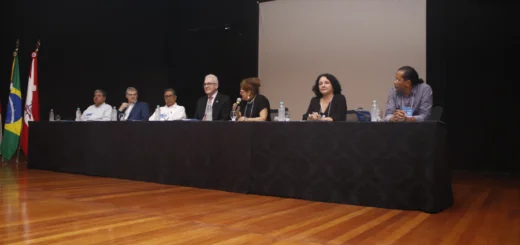Brief Overview of Violence in the Amazon in 2019
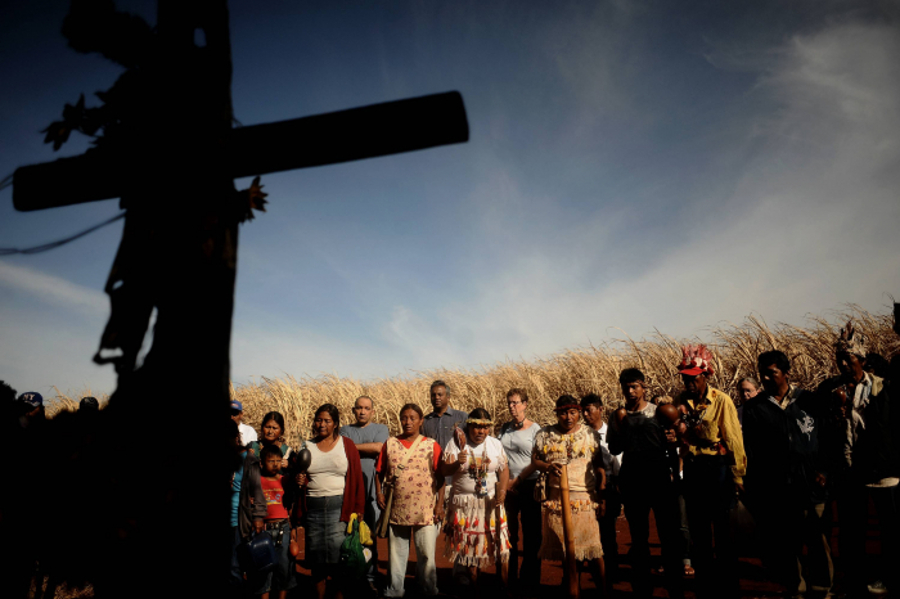
Human rights violations in the Amazon present worrisome trends in recent years
When arriving by plane to the city of Tabatinga, it is possible to fear, for a moment, that the pilot was mistaken. The airstrip is hidden by the vastness of the Amazon rainforest. After the scare, one sees an urban setting whose tranquility is only hindered by the comings and goings of the motorcycles, the main mode of local transport. The apparent peace seems strange to those preparing to enter a stronghold of Brazilian drug trafficking on the triple border with Colombia and Peru.
The presence of the team of journalists that accompanied the author was justified by the coverage of the International Seminar on Political Ecology in May of this year. Prior to our arrival, our contact with the city came from Brazilian press reports such as Favela Amazônia, an article from the O Estado de São Paulo newspaper on the misery in Tabatinga. Videos produced by the newspaper showed indigenous people looking for food on an open dump, a portrait of the absence of minimal services in Brazilian cities.
Another clipping, from the Sputnik website, referred to the Amazonian municipality as “a lawless outpost”, and spoke about the influence of drug trafficking in the daily life of Tabatinga. The featured image was a metal siding on which graffiti from the Família do Norte (NDF) (Family of the North) drug faction claims possession over the territory, announcing “the border is ours”.
The NDF gained visibility with the wave of rebellions in northern prisons from 2015. Among other reasons, the rebellions were made public as part of a war between the Primeiro Comando da Capital (PCC) (First Capital Command), the largest criminal faction in the region, from São Paulo, and Comando Vermelho (CV) (Red Command), the main faction active in the metropolitan region of Rio de Janeiro.
Allied with the CV, the NDF has quartered and beheaded several CCP members detained in prisons in the North to ensure sovereignty over drug trafficking routes in the region. The severity of the factional conflict was the culmination of the massacre at the Anísio Jobim Penitentiary Complex (Compaj), located in the city of Manaus, on the first day of 2017. It was the second most violent massacre in the history of the Brazilian prison system, accounting for 56 deaths. Given the NDF’s history of extreme violence, going to Tabatinga was, at the very least, worrisome. To the surprise of the journalists, who had just landed in the city, accessible only by air or water, we were soon in front of the siding in question. However, we did not expect to find the NDF’s “deed of possession” on Avenida da Amizade, the city’s main thoroughfare, which connects with the municipality of Leticia in Colombia.
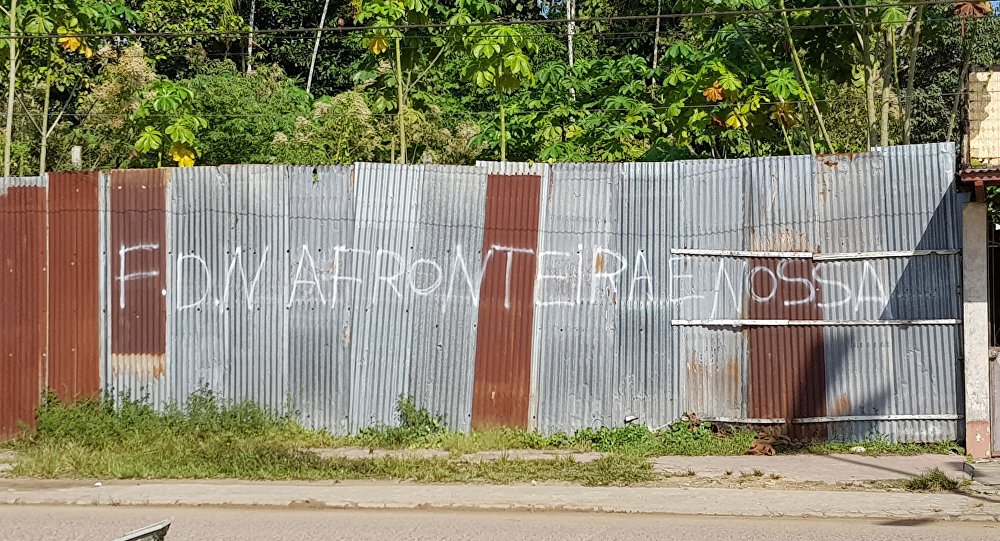
Spray graffiti from the FDN used as territorial demarcation on the triple border between Brazil, Colombia and Peru, in the city of Tabatinga, Amazonas state. Source: Sputnik.
Even here, in the center of Tabatinga, the graffiti on the siding seemed not to worry the inhabitants, and life went on smoothly – which dispelled the picture painted by the press of an extremely violent municipality. The impression would be reinforced, however, when a motorcycle taxi driver naturally reported that it was impossible to pass the border post one evening as criminals had left a body at the scene.
Near the Amazon Trapeze, the region that accounts as one of the largest volume of cocaine production in the world, Tabatinga did not seem to suffer directly from the action of drug trafficking. This perception is shared by Luiz Fábio Paiva, in his article At the margins of the nation state: the speeches of violence on the triple Amazonian frontier (Nas margens do Estado-nação: as falas da violência na tríplice fronteira amazônica). The author conducted several interviews with residents of Tabatinga to understand their own notions of violence. His article shows that the bloody violence of drug trafficking (a field day for press exhibitionism) is not the only form of violence to befall the Amazonian populations.
Many of those from Tabatinga interviewed by Luiz Fábio stated in the conversations that only those directly involved in crime die.
“It works like this [gun crimes]. You buy some drugs, so like, you buy on credit. Then, all of a sudden you go off with the drugs, either because the police arrest you or because you want to cheat the guy. Then they call and say either you pay for my drugs or you die. And that’s how it works, if you don’t pay, you die. You can run away, but never come back here, because on the day you come back, it may have been 10 years since it happened, you think they forgot, but they don’t forget. When you set foot here, usually, they already know you’re coming, there’s already a gunman waiting for you. They kill you there and then! That’s how it is! (Civil Police Officer interviewed by Luiz Fábio)”.
In addition to slow physical and subjective violence, Amazonians have to deal with other forms of violence, such as land grabbing, colonization of nature through illegal predatory extraction of natural resources to maintain capitalism, human trafficking, and expansion of the agricultural frontier. This is a frontier that, with the support of the State, has so far had 439 types of pesticides authorized for use, which, among other problems, directly affect the physical integrity, moral integrity, interior spaces and the very ways of life of traditional communities.
Like Luiz Fábio’s work, many other articles refer to this violence using the term socio-environmental conflicts; situations of confrontation between the interests of local populations and other social agents. This diffuse group is not restricted to people and permeates the economic development model that imposes itself on all regions of the world, prioritizing profit over social welfare.
Socio-environmental Conflicts
Pedro Rapozo, professor at the Amazonas State University (UEA) and coordinator of the research group Nucleus of Social and Environmental Studies of the Amazon (Núcleo de Estudos Socioambientais da Amazônia – NESAM), states that socio-environmental conflicts are also marked by inequalities in political and economic capital. In the Brazilian case, both are represented in the power disputes in the Legislative and Executive fields, related to territorial demarcation policies and their judicial delays.
“Socio-environmental conflicts maintain a relationship of agents with available natural resources. The mediation of these resources is represented by the impacts generated by human action in these environments. Conflicts are also considered through divergent lifestyle values, non-consensual ideologies between hegemonic and non-hegemonic groups that dispute power for a particular good or predisposed natural resource,” says the sociologist.
In the article Invisibility and Violence in socioenvironmental conflicts in indigenous lands of the Alto Solimões microregion, Amazonas Brazil, not yet published, Pedro Rapozo clarifies that the dispute for power generates social and environmental clashes between agents such as the state, landowners, expropriated territories, squatters, artisanal fishermen, farmers, Quilombolas and indigenous peoples. The researcher notes that the occurrence of conflicts motivated by changes in lifestyle, by the permanence and survival of rural Amazonian societies, intensified with the advance of agribusiness and mega-enterprises in the region.
“We see this clearly. On the one hand, civil society is established from social groups, peasants, rural workers, squatters, fishermen, and indigenous people. On the other, there are state actions, such as financing policies for large economic projects. These are examples of how this happens in the Amazon. In fact, there is big capital on one side and civil society on the other. It does not mean that, within civil society itself, there are no conflicts of interest between fishermen, indigenous peoples, riparian populations, and Quilombolas, and it is not one specific group that is especially impacted by these conflicts, considering that they are the result of direct interest in the territory, its occupation and use for some good. But given the context of the Amazon, we clearly have very strong opposition from rural societies, on the one hand, being criminalized, and, on the other hand, the progress of projects in the Amazon being due to the influence of the state.” explains Rapozo.
Violence in numbers
In September, two reports on violence in the Amazon were published. The first, from Human Rights Watch (HRW), discusses how violence and impunity have catapulted deforestation in the region. In turn, the compilation of the Indigenous Missionary Council (Conselho Indigenista Missionário – Cimi) scrutinizes the picture of violence against indigenous peoples.
In the Mafias do Ipê report on Violence and Deforestation in the Amazon (Máfias do Ipê: Violência e Desmatamento na Amazônia), HRW examined 28 murders, most from 2015 – as well as 4 attempted murders and more than 40 death threats. The analysis found that in most cases the crimes were directly linked to illegal activities by loggers, prospectors and squatters in the region. Among the victims are indigenous people and members of other traditional communities who reported the criminals, as well as public agents active in the monitoring and combat of said activities.
The scenario of omission on the part of the state is expressed in the impunity of the criminals involved in the murders, threats and extortion. According to the HRW report, among the more than 300 murders analyzed by the Pastoral Land Commission (Comissão Pastoral da Terra – CPT), a non-governmental organization that records complaints not processed by the competent official bodies, only 14 were tried; of the 28 murders analyzed by HRW, only two went to court. None of the 40 death threats examined went to trial.
This impunity is largely due to the inadequate conduct of investigations by police institutions. Local police recognize the shortcomings and attribute them to the occurrence of deaths in remote areas. However, Human Rights Watch has documented serious omissions, such as the lack of autopsies in investigations into city deaths not far from police stations.
Regarding this form of violence, Pedro Rapozo states that it is not just “a matter of murders and attempted murders as materialized physical violence that can be thought of as consequences of the conflict. The imposition of certain practices, certain state policies, the lack of assurance of land use rights, the inefficiency in addressing conflict judicialization processes, and the way the state and certain economic agents deal with this relationship with impacted agents, can also be seen as a model of symbolic violence, also expressed as a result of these conflicts ”.
Indigenous peoples, who have long played the role of monitors and defenders of forests to combat deforestation (through warnings and denunciations), are particularly threatened by weakened environmental protection bodies and laws. The report on Violence Against Indigenous Peoples in Brazil: 2018 (Violência Contra os Povos Indígenas no Brasil: Dados de 2018), published by Cimi in September, shows that last year there were 109 cases of “possessive invasions, illegal exploitation of natural resources, and various damages to heritage”, compared to 96 reported in 2017. Between January and September 2019, Cimi counted 160 cases of invasion of indigenous lands, spread across 153 territories in 19 states of Brazil.
Until the release of the report, Cimi had observed 941 cases of violence against the heritage of indigenous peoples. These are attacks related to omission and delays in land regularization; conflicts over territorial rights; illegal exploitation of natural resources; and various damages to heritage. In this context, the agency pays special attention to the case of the Munduruku indigenous land, where it is estimated that about 500 artisanal mines have already been installed.
Regarding violence against individuals, 110 cases were registered in relation to abuse of power; death threats; various other threats; manslaughter; willful bodily harm; racism and cultural ethnic discrimination; attempted murder; and sexual violence in 2018. In the same year there were also 135 cases of murder of indigenous people, 25 more than those recorded in 2017. Besides the violence against indigenous peoples due to State omission or the criminal violation of rights, there are also suicides, increased child mortality, and deaths due to a lack of medical assistance, among others.
As the Special Secretariat of Indigenous Health (Secretaria Especial de Saúde indígena – Sesai) points out, only partial data is available, as new cases could come to be reported. Thus, it is clear that the actual situation regarding the murder of indigenous people is even more serious than the statistics indicate.
Relationship with deforestation
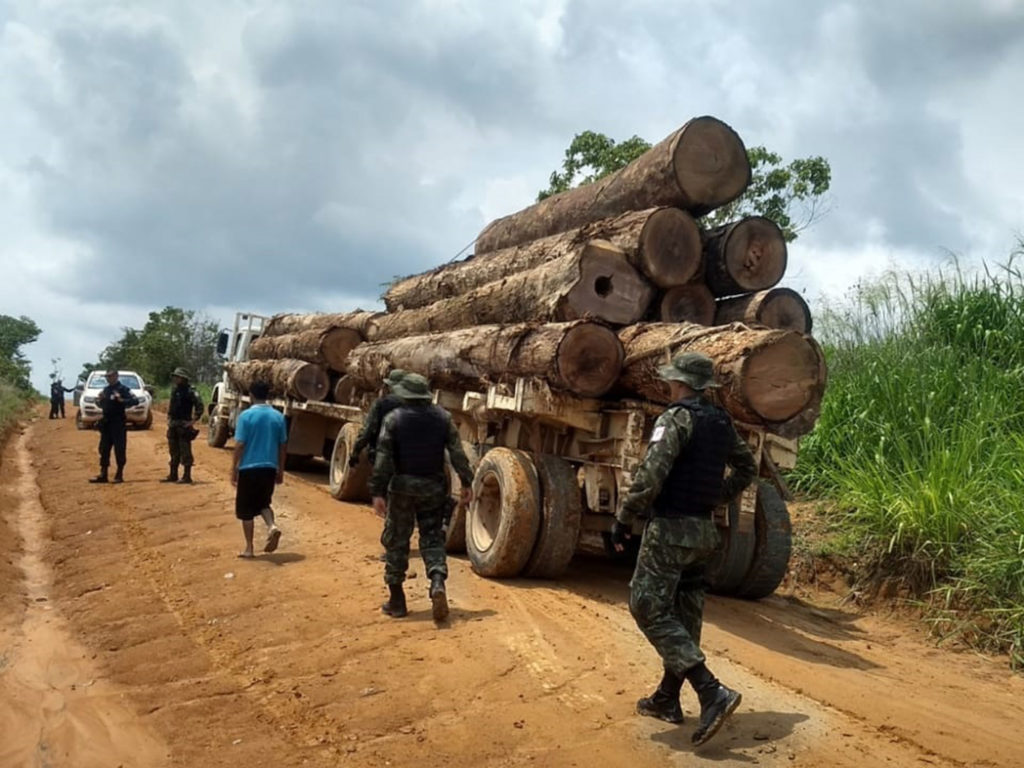
The operation “Pé ybyrá” aprehended ilegal wood logger’s machinery in the BR-163 highway, in november 2019, state of Pará, Brazil. Source: ASCOM/SEMAS.
In 2016, with the signing of the Paris agreement, Brazil pledged to eliminate illegal deforestation in the Amazon by 2030. Between 2004 and 2012, deforestation in the Amazon was reduced by over 80%, from almost 28,000 km² of forest destroyed per year to less than 4,600 km². After approval of the new Forest Code (Código Florestal) in the National Congress, under intense lobbying from the ruralist contingent, deforestation rose again in 2012. In 2018, it reached 7,500 km², and its extent is expected to be even greater in 2019.
Brazil’s success in combating deforestation prior to 2012 was partly due to the use of near-real-time satellite imagery to locate and close down illegal logging sites. Another success factor was the creation of protected areas – conservation units and indigenous lands – covering hundreds of thousands of square kilometers across the Amazon region, where legal restrictions on land and resource use protect the forest.
On November 18th of this year, the National Institute for Space Research (Instituto Nacional de Pesquisas Espaciais – Inpe) published the results of the Satellite Deforestation Monitoring Project for the Legal Amazon (Projeto de Monitoramento do Desmatamento na Amazônia Legal por Satélite – Prodes), which monitors deforestation over a period of one year. The index was obtained through the satellite image analysis of Prodes, responsible for accounting for the areas that show to be at the end of the deforestation process. The numbers are 42% higher than the alert from the Real Time Deforestation Detection (Detecção de Desmatamento em Tempo Real – Deter) system, another INPE system – monitoring the Amazon region on a daily basis – which predicted a total of 6,833.9 km² of deforestation for the period.
Among the factors that are responsible for the increase in deforestation in 2019 are the adoption of sophisticated logging techniques, which are more difficult to identify through satellite surveillance, and the budget and human cuts suffered by federal environmental agencies, which reduced the ability to investigate and punish loggers.
Another highlight of the HRW report is the government’s lack of interest in investigating or even filing complaints regarding illegal forest activities. This scenario of impunity and reduced enforcement gives greater freedom for loggers, squatters, and prospectors, among other criminals, to carry out their activities and aggravate the destruction of Amazonian biomes, besides intensifying oppression against the people who denounce them to protect their physical integrity, their way of life, or the environment itself. It is noteworthy that the relaxation of environmental legislation and the indifference to denunciations leaves civil society powerless, with no alternative forms of action to intervene in deforestation.
Debate on the Amazon in Oxford
Reports published by Human Rights Watch and the Indian Missionary Council (Conselho Indigenista Missionário) this year, along with data recently released by Prodes, show a worrying trend regarding the safety of traditional populations in the Amazon region. This year, we face weekly serious news about deforestation, land invasion, threats, and killings of indigenous leaders and social movements, as well as the much-talked-about “fire day”.
We have seen processes of demarcation of indigenous lands being halted (no resumption expected); the weakening of environmental inspection and protection bodies; the release of more than 250 pesticides for use in national agriculture; and an increase in the number of attacks by criminals on indigenous lands and other Union assets, among other controversial facts, many of which are connected to the discourse of President Jair Bolsonaro, as demonstrated by reports from the main-stream press and academics that follow the theme.
Taking into account this scenario, the University of Oxford will hold the International Colloquium “Amazon: Rising Violence and Disturbing Trends”, which will bring important indigenous and social movement leaders to dialogue with teachers, artists and researchers dedicated to the socio-environmental problems of the Amazon Region between January 31st and February 2nd, 2020. The main objective will be to debate legacies of the past, to question responsibilities, and to assess the alarming rates of violence, inequality and food insecurity.
The colloquium is part of a broad effort to decolonize scientific practices through a North-South dialogue that recognizes the importance of an ethic based on socio-environmental reciprocity. The Oxford edition follows on from discussions held at the International Seminar on Political Ecology and is part of the activities of the AgroCultures international research network, which hopes to foster scientific and cultural production as a result of the event and to strengthen ties between thinkers from the Amazon and the rest of the world.
The event will produce a number of concrete results, such as technical and scientific publications, denunciation of the serious situation facing many social groups due to the increasing attack on basic rights and commons, and proposals to the national governments of the region to inform economic, social and environmental policy changes.


